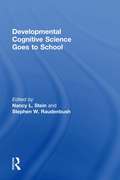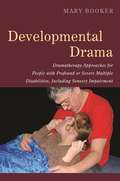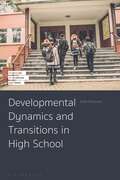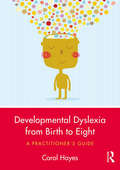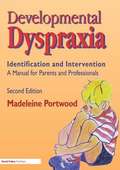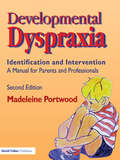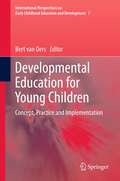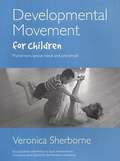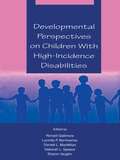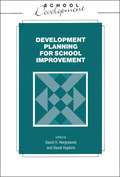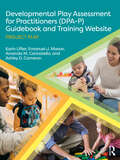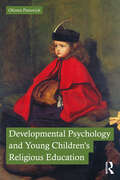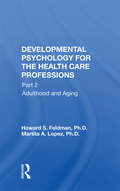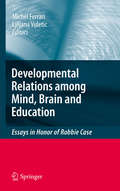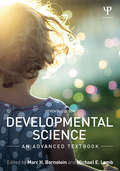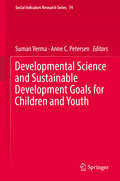- Table View
- List View
Developmental Cognitive Science Goes to School
by Nancy L. Stein Stephen W. RaudenbushThis book addresses core issues related to school learning and the use of developmental/cognitive science models to improve school-based instruction. The contributors comprise a veritable "who's who" of leading researchers and scientists who are broadly trained in developmental psychology, cognitive science, economics, sociology, statistics, and physical science, and who are using basic learning theories from their respective disciplines to create better learning environments in school settings. Developmental Cognitive Science Goes to School: presents evidence-based studies that describe models of complex learning within specific subject-area disciplines focuses on domain knowledge and how this knowledge is structured in different domains across the curriculum gives critical attention to the topic of the ability to overcome errors and misconceptions addresses models that should be used to begin instruction for populations of children who normally fail at schooling. This is a must-read volume for all researchers, students, and professionals interested in evidence-based educational practices and issues related to domain-specific teaching and learning.
Developmental Drama: Dramatherapy Approaches for People with Profound or Severe Multiple Disabilities, Including Sensory Impairment
by Mary Adelaide BookerPeople living with severe or profound multiple disabilities (PMLD) can often struggle to connect with the world around them. This book shows how, through enjoying dramatic interaction, they can develop their communication skills, learn to deal with emotions more effectively and gain a greater understanding of their physical and social environment. This guide presents a variety of ways in which drama can be used as a medium for assisting the social and emotional development of people with PMLD, including sensory impairment. It fully explains techniques that are proven to build confidence and promote participation, and illustrates how to include support staff effectively within the process. Charting the author's own journey as a dramatherapist, it clarifies in detail some effective approaches and how to address key issues that arise in dramatherapy practice. This is an accessible and life-saving guide for practitioners looking to use drama in work with people with PMLD, but are unsure where to begin.
Developmental Drama: Dramatherapy Approaches for People with Profound or Severe Multiple Disabilities, Including Sensory Impairment (PDF)
by Mary Adelaide BookerPeople living with severe or profound multiple disabilities (PMLD) can often struggle to connect with the world around them. This book shows how, through enjoying dramatic interaction, they can develop their communication skills, learn to deal with emotions more effectively and gain a greater understanding of their physical and social environment. This guide presents a variety of ways in which drama can be used as a medium for assisting the social and emotional development of people with PMLD, including sensory impairment. It fully explains techniques that are proven to build confidence and promote participation, and illustrates how to include support staff effectively within the process. Charting the author's own journey as a dramatherapist, it clarifies in detail some effective approaches and how to address key issues that arise in dramatherapy practice. This is an accessible and life-saving guide for practitioners looking to use drama in work with people with PMLD, but are unsure where to begin.
Developmental Dynamics and Transitions in High School (Transitions in Childhood and Youth)
by Sofie PedersenThis book is about young people and their transitions throughout their first year of high school, deepening our understanding of how it is to be young and enter new institutional settings, and how to understand the developmental dynamics of youth life. It explores the everyday life of six young people as they enter high school and follows them closely as they encounter and try to make sense of the different standards, values, and demands that are built into the institutional setting of high school. The chapters explore the entanglements of personal motive orientation, interpersonal dynamics, institutional values and demands, as well as societal standards, and how subtle negotiations of who one is and ought to be are interwoven into the fabrics of everyday life. Hence the book explores variations on an institutional level – as different high school environments – along with variations on an interpersonal level, insisting on a person-environment reciprocity in the study of development. Using cultural-historical activity theory and ecological psychology derived from theorists including Bang, Barker & Wright, Gibson, Lewin, Hedegaard, Ilyenkov, Stetsenko, and Vygotsky, Sofie Pedersen argues that developmental dynamics among young people cannot be reduced to individual nor social processes alone but are connected to institutional conditions and to concrete places. By insisting on a wholeness approach to the understanding of youth development, Pedersen reveals the developmental dynamics that unfold in the everyday lives of young people, and sheds new light on youth life dynamics, including the challenges that young people face.
Developmental Dynamics and Transitions in High School (Transitions in Childhood and Youth)
by Sofie PedersenThis book is about young people and their transitions throughout their first year of high school, deepening our understanding of how it is to be young and enter new institutional settings, and how to understand the developmental dynamics of youth life. It explores the everyday life of six young people as they enter high school and follows them closely as they encounter and try to make sense of the different standards, values, and demands that are built into the institutional setting of high school. The chapters explore the entanglements of personal motive orientation, interpersonal dynamics, institutional values and demands, as well as societal standards, and how subtle negotiations of who one is and ought to be are interwoven into the fabrics of everyday life. Hence the book explores variations on an institutional level – as different high school environments – along with variations on an interpersonal level, insisting on a person-environment reciprocity in the study of development. Using cultural-historical activity theory and ecological psychology derived from theorists including Bang, Barker & Wright, Gibson, Lewin, Hedegaard, Ilyenkov, Stetsenko, and Vygotsky, Sofie Pedersen argues that developmental dynamics among young people cannot be reduced to individual nor social processes alone but are connected to institutional conditions and to concrete places. By insisting on a wholeness approach to the understanding of youth development, Pedersen reveals the developmental dynamics that unfold in the everyday lives of young people, and sheds new light on youth life dynamics, including the challenges that young people face.
Developmental Dyslexia from Birth to Eight: A Practitioner’s Guide
by Carol HayesDevelopmental Dyslexia from Birth to Eight takes a fresh approach to a condition which is often poorly understood and unjustly stigmatised. Illuminating the latest neurological advances in the field, this book will empower educational professionals to play a decisive role in supporting and encouraging children with dyslexia. With an overarching focus on the ways in which practitioners can advance children’s development and learning, Developmental Dyslexia from Birth to Eight recognises the varying guises in which this information-processing difference might present, and addresses the challenges that this creates for children and practitioners alike. Each chapter provides the reader with a thorough examination and explanation of dyslexia, along with reflective examples, case studies and relevant further reading. Areas of focus include: The origins and identification of dyslexia Intervention strategies and alternative therapies Observation and assessment Dyslexia and English as a foreign language Dyslexia-friendly settings National and global policy on provision for dyslexic children An engaging and accessible guide, this book will be an invaluable resource for educational practitioners and childcare specialists seeking to enhance their knowledge and understanding of dyslexia, to better support the children in their care.
Developmental Dyslexia from Birth to Eight: A Practitioner’s Guide
by Carol HayesDevelopmental Dyslexia from Birth to Eight takes a fresh approach to a condition which is often poorly understood and unjustly stigmatised. Illuminating the latest neurological advances in the field, this book will empower educational professionals to play a decisive role in supporting and encouraging children with dyslexia. With an overarching focus on the ways in which practitioners can advance children’s development and learning, Developmental Dyslexia from Birth to Eight recognises the varying guises in which this information-processing difference might present, and addresses the challenges that this creates for children and practitioners alike. Each chapter provides the reader with a thorough examination and explanation of dyslexia, along with reflective examples, case studies and relevant further reading. Areas of focus include: The origins and identification of dyslexia Intervention strategies and alternative therapies Observation and assessment Dyslexia and English as a foreign language Dyslexia-friendly settings National and global policy on provision for dyslexic children An engaging and accessible guide, this book will be an invaluable resource for educational practitioners and childcare specialists seeking to enhance their knowledge and understanding of dyslexia, to better support the children in their care.
Developmental Dyspraxia: Identification and Intervention - A Manual for Parents and Professionals (PDF)
by Madeleine PortwoodAims to give parents, teachers and health professionals the confidence and know-how to diagnose and assess dyspraxia. The text includes: background information on the neurological basis of the condition; strategies for identification, diagnosis and assessment; proven programmes of intervention which can be monitored by anyone closely involved with the child; strategies to improve curricular attainments; remediation activities to develop perceptual and motor skills; programmes to develop self-esteem; and information about where to find help.
Developmental Dyspraxia: Identification and Intervention: A Manual for Parents and Professionals
by Madeleine PortwoodFirst published in 2007. Routledge is an imprint of Taylor & Francis, an informa company.
Developmental Dyspraxia: Identification and Intervention: A Manual for Parents and Professionals
by Madeleine PortwoodFirst published in 2007. Routledge is an imprint of Taylor & Francis, an informa company.
Developmental Education for Young Children: Concept, Practice and Implementation (International Perspectives on Early Childhood Education and Development #7)
by Bert Van OersDevelopmental Education is an approach to education in school that aims at promoting children’s cultural development and their abilities to participate autonomously and well-informed in the cultural practices of their community. From the point of view of Cultural-historical Activity theory (CHAT), a play-based curriculum has been developed over the past decades for primary school, which presents activity contexts for pupils in the classroom that create learning and teaching opportunities for helping pupils with appropriating cultural knowledge, skills, and moral understandings in meaningful ways. The approach is implemented in numerous Dutch primary schools classrooms with the explicit intention to support the learning of both pupils and teachers. The book focuses especially on education of young children (4 – 8 years old) in primary school and presents the underpinning concepts of this approach, and chapters on examples of good practices in a variety of subject matter areas, such as literacy (vocabulary acquisition, reading, writing), mathematics, and arts. Successful implementation of Developmental Education in the classroom strongly depends on dynamic assessment and continuous observations of young pupils’ development. Strategies for implementation of both the teaching practices and assessment strategies are discussed in detail in the book.
Developmental Movement For Children: Mainstream, Special Needs And Pre-school (PDF)
by Veronica SherborneCore text for the internationally renowned Sherborne children's developmental movement programme. A new forward and new resources listed. In this practical and thought-provoking book, Veronica Sherborne shows how developmental movement has a crucial role to play in the lives of all children. Central to her theory is the belief that relating to oneself and relating to other people are essential for the satisfactory development of us all. Developmental movement can be particularly beneficial to children with learning disabilities, children with physical disabilities, and children who are emotionally and behaviourly disturbed. The book offers practical help in understanding and meeting children's needs. It covers what to teach and why, and shows in detail - with the aid of marvellously expressive photographs - how to set about carrying out a planned programme of activities that are geared to the needs of specific groups.
Developmental Perspectives on Children With High-incidence Disabilities (The LEA Series on Special Education and Disability)
by Ronald Gallimore Lucinda P. Bernheimer Donald L. MacMillan Deborah L. Speece Sharon VaughnThis volume has two purposes. The first is to summarize, substantiate, and extend current knowledge on the development of children with high incidence disabilities--most notably, learning disabilities, behavioral disorders, and mild mental retardation. The second is to honor the career of Professor Barbara K. Keogh and her contributions to the developmental study of children with high incidence disabilities. Internationally recognized for her accomplishments, Keogh is esteemed for her originality and clarity of thought. For nearly forty years, she has set an extraordinary model of analytic rigor combined with a kind and generous manner that inspires, supports, and sets an exacting standard of scholarship. The contributing authors to this volume represent only a fraction of the students and scholars touched by her distinguished career. In conceiving this volume, the editors sought to represent the topics, problems, and issues to which Keogh has devoted herself. They invited chapters that summarize what is known about the high incidence handicapping conditions that her research has mainly addressed and sought to reflect the probing, questioning style that she brings to her own work. Researchers, policymakers, and graduate students in special education and associated disciplines who seek to stay current will find this volume crucial reading.
Developmental Perspectives on Children With High-incidence Disabilities (The LEA Series on Special Education and Disability)
by Ronald Gallimore Lucinda P. Bernheimer Donald L. MacMillan Deborah L. Speece Sharon R. VaughnThis volume has two purposes. The first is to summarize, substantiate, and extend current knowledge on the development of children with high incidence disabilities--most notably, learning disabilities, behavioral disorders, and mild mental retardation. The second is to honor the career of Professor Barbara K. Keogh and her contributions to the developmental study of children with high incidence disabilities. Internationally recognized for her accomplishments, Keogh is esteemed for her originality and clarity of thought. For nearly forty years, she has set an extraordinary model of analytic rigor combined with a kind and generous manner that inspires, supports, and sets an exacting standard of scholarship. The contributing authors to this volume represent only a fraction of the students and scholars touched by her distinguished career. In conceiving this volume, the editors sought to represent the topics, problems, and issues to which Keogh has devoted herself. They invited chapters that summarize what is known about the high incidence handicapping conditions that her research has mainly addressed and sought to reflect the probing, questioning style that she brings to her own work. Researchers, policymakers, and graduate students in special education and associated disciplines who seek to stay current will find this volume crucial reading.
Developmental Planning for School Improvement
by David HopkinsThis text represents the experiences from six English speaking countries in the field of school development planning. There are chapters discussing staff development, quality reviews and school organization and effectiveness.
Developmental Play Assessment for Practitioners (DPA-P) Guidebook and Training Website: Project Play
by Karin Lifter Emanuel J. Mason Amanda M. Cannarella Ashley D. CameronDevelopmental Play Assessment for Practitioners (DPA-P) Guidebook and Training Website: Project Play offers a comprehensive assessment of naturally occurring play activities for evaluating young children’s developmental progress accurately, so that useful interventions can take place as early as possible. It can be used by practitioners in a wide range of educational and therapeutic settings and is designed to support developmental progress through planning interventions in play, and using what we know about a child’s progress in play to plan play-based interventions in cognition, language, motor, social-emotional, and self-help skills. The guidebook and training website provide a comprehensive introduction to how to successfully use the assessment with infants, toddlers, and young children with disabilities or at risk for disabilities. The comprehensive guidebook offers an overview of the DPA-P and Project Play, defines play, discusses the background literature on play, and explains why this assessment is needed. Clear guidance helps practitioners and family members understand play, how to evaluate play, and how to use play for different purposes. The guidebook offers: an introduction to the comprehensive training website and how to use it understanding of the categories of play assessed and their definitions guidance on how to administer the assessment and prepare a summary evaluation of a child’s performance clear instructions for the coding sheets and scoring guidelines for constructing sets of toys guidance on taking the results of the DPA-P evaluation of a child’s progress in play to develop a plan of activities for intervention explanation of how you evaluate activities at the absence, basic, emergence, and mastery levels for developing a plan suggestions for assembling sets of toys for intervention, based on toys available in children’s homes and early childhood settings procedures for facilitating or teaching play activities to children who are developing more slowly than their peers technical aspects of the assessment To make the DPA-P as flexible as possible for all practitioners, it also offers guidance on adaptations for administering the test, in the coding sheets, with toys to enhance cultural appropriateness for gathering the observations, and for supporting interventions in play. The Developmental Play Assessment for Practitioners (DPA-P) can be used in natural settings and takes 30 minutes to complete. It is a valuable tool for all those who serve, or are training to serve, young children in early childhood settings, schools, service agencies, colleges, and universities. It will be of great benefit for early intervention personnel, speech-language pathologists, physical therapists, occupational therapists, and psychologists.
Developmental Play Assessment for Practitioners (DPA-P) Guidebook and Training Website: Project Play
by Karin Lifter Emanuel J. Mason Amanda M. Cannarella Ashley D. CameronDevelopmental Play Assessment for Practitioners (DPA-P) Guidebook and Training Website: Project Play offers a comprehensive assessment of naturally occurring play activities for evaluating young children’s developmental progress accurately, so that useful interventions can take place as early as possible. It can be used by practitioners in a wide range of educational and therapeutic settings and is designed to support developmental progress through planning interventions in play, and using what we know about a child’s progress in play to plan play-based interventions in cognition, language, motor, social-emotional, and self-help skills. The guidebook and training website provide a comprehensive introduction to how to successfully use the assessment with infants, toddlers, and young children with disabilities or at risk for disabilities. The comprehensive guidebook offers an overview of the DPA-P and Project Play, defines play, discusses the background literature on play, and explains why this assessment is needed. Clear guidance helps practitioners and family members understand play, how to evaluate play, and how to use play for different purposes. The guidebook offers: an introduction to the comprehensive training website and how to use it understanding of the categories of play assessed and their definitions guidance on how to administer the assessment and prepare a summary evaluation of a child’s performance clear instructions for the coding sheets and scoring guidelines for constructing sets of toys guidance on taking the results of the DPA-P evaluation of a child’s progress in play to develop a plan of activities for intervention explanation of how you evaluate activities at the absence, basic, emergence, and mastery levels for developing a plan suggestions for assembling sets of toys for intervention, based on toys available in children’s homes and early childhood settings procedures for facilitating or teaching play activities to children who are developing more slowly than their peers technical aspects of the assessment To make the DPA-P as flexible as possible for all practitioners, it also offers guidance on adaptations for administering the test, in the coding sheets, with toys to enhance cultural appropriateness for gathering the observations, and for supporting interventions in play. The Developmental Play Assessment for Practitioners (DPA-P) can be used in natural settings and takes 30 minutes to complete. It is a valuable tool for all those who serve, or are training to serve, young children in early childhood settings, schools, service agencies, colleges, and universities. It will be of great benefit for early intervention personnel, speech-language pathologists, physical therapists, occupational therapists, and psychologists.
Developmental Psychology and Young Children’s Religious Education
by Olivera PetrovichDevelopmental Psychology and Young Children’s Religious Education sets out to identify the conceptual pre-requisites for young children’s religious education learning and clearly highlights the challenges that children and their teachers encounter in the RE educational process. Based on a study with 431 children aged 5 to 7 years from different schools, faith and non-faith, and 47 teachers from the same schools as the children, this book offers an insightful look into younger children’s religious education, providing statistical evidence to dismantle the belief that young children lack the ability to conceptualise God in abstract terms. The information obtained from these children and their teachers reveals a major discrepancy between the teachers’ perceptions of young children’s conceptual abilities for RE learning, on the one hand, and children’s actual abilities revealed in their responses throughout the study, on the other. Based on the evidence described in the volume, Petrovich argues that teacher-training courses for primary RE need to be designed to include a substantial component of contemporary developmental research that is of direct relevance to children’s conceptual abilities and understanding of abstract concepts. Developmental Psychology and Young Children’s Religious Education is essential reading for students and researchers in developmental psychology, religious education, teacher education, education studies and cultural anthropology.
Developmental Psychology and Young Children’s Religious Education
by Olivera PetrovichDevelopmental Psychology and Young Children’s Religious Education sets out to identify the conceptual pre-requisites for young children’s religious education learning and clearly highlights the challenges that children and their teachers encounter in the RE educational process. Based on a study with 431 children aged 5 to 7 years from different schools, faith and non-faith, and 47 teachers from the same schools as the children, this book offers an insightful look into younger children’s religious education, providing statistical evidence to dismantle the belief that young children lack the ability to conceptualise God in abstract terms. The information obtained from these children and their teachers reveals a major discrepancy between the teachers’ perceptions of young children’s conceptual abilities for RE learning, on the one hand, and children’s actual abilities revealed in their responses throughout the study, on the other. Based on the evidence described in the volume, Petrovich argues that teacher-training courses for primary RE need to be designed to include a substantial component of contemporary developmental research that is of direct relevance to children’s conceptual abilities and understanding of abstract concepts. Developmental Psychology and Young Children’s Religious Education is essential reading for students and researchers in developmental psychology, religious education, teacher education, education studies and cultural anthropology.
Developmental Psychology For The Health Care Professions, Part Ii: Young Adult Through Late Aging
by Howard. S. FeldmanFirst published in 1982. Since the 1960s, there has been growing interest in and research on the adult years of the life cycle. Previously, developmental studies had focused on childhood and adolescence, in which an orderly relationship between age and growth was assumed. This volume looks at three periods of adulthood identified on the basis of chronological age: young adulthood, from 18 to 40; middle adulthood, from 40 to 65; and later adulthood, from 65 until death. The authors of the series volumes are behavioral scientists with considerable experience in the education of health care professionals. Most of them are also clinicians, and their varied experience enables them to present their topics in a readable fashion. The content of the texts presumes only a very basic knowledge of the behavioral sciences, and emphasis is placed on the practical implications of research findings for health care delivery.
Developmental Psychology For The Health Care Professions, Part Ii: Young Adult Through Late Aging
by Howard. S. FeldmanFirst published in 1982. Since the 1960s, there has been growing interest in and research on the adult years of the life cycle. Previously, developmental studies had focused on childhood and adolescence, in which an orderly relationship between age and growth was assumed. This volume looks at three periods of adulthood identified on the basis of chronological age: young adulthood, from 18 to 40; middle adulthood, from 40 to 65; and later adulthood, from 65 until death. The authors of the series volumes are behavioral scientists with considerable experience in the education of health care professionals. Most of them are also clinicians, and their varied experience enables them to present their topics in a readable fashion. The content of the texts presumes only a very basic knowledge of the behavioral sciences, and emphasis is placed on the practical implications of research findings for health care delivery.
Developmental Relations among Mind, Brain and Education: Essays in Honor of Robbie Case
by Michel Ferrari Ljiljana VuleticRobert S. Siegler Robbie Case: A Modern Classic About 15 years ago, Robbie asked me what I thought of a talk we had just heard. I indicated that I hadn’t much liked it and noted several serious problems. Robbie agreed with all of the criticisms, but said that he nonetheless liked the talk, because there was one good idea in it that he could use. I agreed with him that the idea was a good one, but it took me a while to understand the wisdom of his position. If there’s one useful idea in a talk, then hearing it has been worthwhile, even if the talk also has numerous de?ciencies. On that day and on many others, talking with Robbie changed my thinking for the better. Robbie Case was in many ways a classic developmental psychologist of the old school. The depth and breadth of his theory; the range of age groups, populations, and topics that he studied; and his efforts to connect theory and application are all reminiscent of the greats of the past: Baldwin, Dewey, Piaget, Vygotsky, and Bruner.
Developmental Science: An Advanced Textbook
by Marc H. Bornstein Michael E. LambDevelopmental Science: An Advanced Textbook is the most complete and cutting-edge introduction to the field available today. Since its initial publication, the key purpose of the text has been to furnish inclusive developmental perspectives on all substantive areas in psychology—neuroscience, perception, cognition, language, emotion, and social interaction. This edition is no exception, as it continues to underscore the dynamic and exciting status of contemporary developmental science. In this Seventh Edition, Marc H. Bornstein and Michael E. Lamb once again invite international experts to prepare original, comprehensive, and topical treatments of the major areas of developmental science, which are masterfully woven into a single coherent volume. Some chapters in this edition are new, and those carried forward from the sixth edition have been extensively revised. This volume represents faithfully the current status of scholarly efforts in all aspects of developmental science. Ideal for advanced undergraduate and introductory graduate courses, the text is accompanied by a website with supplementary material for students and instructors, including chapter outlines, topics to think about before reading, glossaries, and suggested readings.
Developmental Science: An Advanced Textbook
by Marc H. Bornstein Michael E. LambDevelopmental Science: An Advanced Textbook is the most complete and cutting-edge introduction to the field available today. Since its initial publication, the key purpose of the text has been to furnish inclusive developmental perspectives on all substantive areas in psychology—neuroscience, perception, cognition, language, emotion, and social interaction. This edition is no exception, as it continues to underscore the dynamic and exciting status of contemporary developmental science. In this Seventh Edition, Marc H. Bornstein and Michael E. Lamb once again invite international experts to prepare original, comprehensive, and topical treatments of the major areas of developmental science, which are masterfully woven into a single coherent volume. Some chapters in this edition are new, and those carried forward from the sixth edition have been extensively revised. This volume represents faithfully the current status of scholarly efforts in all aspects of developmental science. Ideal for advanced undergraduate and introductory graduate courses, the text is accompanied by a website with supplementary material for students and instructors, including chapter outlines, topics to think about before reading, glossaries, and suggested readings.
Developmental Science and Sustainable Development Goals for Children and Youth (Social Indicators Research Series #74)
by Suman Verma Anne C. PetersenThis book presents new scientific knowledge on using developmental science to improving lives of children and youth across the globe. It highlights emerging pathways to sustainability as well as the interconnectedness and interdependence of developmental science and sustainable children and youth development globally. Presenting cross-cultural views and current perspectives on the role of developmental science in the realization of the Sustainable Development Goals for children and youth development, contributors from different disciplines from low-and-middle-income countries or scholars working in these countries capture ground realities of the situation of children and youth in these regions. This book addresses developmental issues related to inequity, gender, health, education, social protection, and needs of vulnerable populations of children and youth. Other areas of focus are improving mechanisms and monitoring frameworks of development and well-being indicators.
